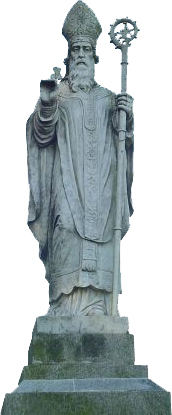Ireland Saints

During the Dark Ages, Ireland was known as the Land of Saints & Scholars, a place of burgeoning culture and Christianity. Here is a selection of Ireland's famous saints who helped spread light during dark times.
 St Patrick - Feast Day 17th March
St Patrick - Feast Day 17th March
Ireland's most prominent patron saint, St Patrick is as much an integral figure in Irish culture as he is in the country's Christianity.
Brought as a slave to Ireland from Wales in the 5th century, St Patrick went on to convert the pagans of Ireland to Christianity. There are a great many legends surrounding St Patrick, from great battles of miracles and magic against druid priests on the Hill of Tara, sprouting shamrocks to explain the holy trinity, and of course banishing all the snakes from Ireland.
St Patrick established his first cathedral at Armagh and ever since Armagh has been the Ecclesiastic capital of Ireland and to this day is the principle seat of both the Catholic and Protestant Archbishops of Ireland.
St Patrick is buried in Downpatrick, close to the site of his very first church at Saul and is buried alongside Ireland's other patron saints, Brigid and Columba in accordance with an ancient legend, that the three saints would be laid to rest together.
Saint Brendan - Feast Day 16th May
St Brendan the Navigator was born in County Kerry and according to legend sailed to the Americas sometime in the 5th Century.
One of Ireland's early saints, St Brendan was born near Tralee in County Kerry, and was ordained by St Erc around 512. St Brendan established monastic settlements at the foot of Mount Brandon on the Dingle peninsula and in later years established his great monastery at Clonfert County Galway, where he is interred.
Amazing stories surround St Brendan most famously of his legendary voyage across the Atlantic in a leather coracle, along with 14 other monks in search of the Garden of Eden. It is believed by many that St Brendan's voyage brought him to North America, a belief supported by theories that Christopher Columbus relied on the legends of St Brendan for his voyage and even visited, Brendan's monastery at Clonfert before heading across the Atlantic. Brendan's voyage was repeated in the 1970s by explorer Tom Severin, whose coracle boat is exhibited at Craggaunowen Castle in Galway.
Brendan also visited Wales, England and Scotland and the cream liqueur, made in Northern Ireland from local whiskey and cream; Saint Brendan's, is named after him.
Saint Brigid - Feast Day 1st February
One of Ireland's Patron Saints, Saint Brigid was daughter of a pagan King of Leinster and a Christian Pictish slave who had been baptized by St. Patrick.
According to legend, Saint Brigid prayed that her beauty be taken so that she could not marry and she became a nun. Renowned for her generosity and care for the poor, Saint Brigid famously converted a dying man by making up a cross with rushes she found on the ground to bless him with, something children in Ireland learn to make in school.
Saint Brigid established the Convent of Cill-Dara in County Kildare around 470 and founded a school of art here, which went on to produce the famous illuminated manuscript; the Book of Kildare.
Saint Brigid is interred in Downpatrick along with St Patrick and St Columcille, Ireland's other patron saints.
St Columba/Columcille - Feast Day 9th June
Saint Columba was born in County Donegal in the 5th Century and was descended from great Irish nobility, tracing his ancestry to Niall of the Nine Hostages, the legendary Irish High King.
From his Irish name Columcille is known as Dove of the Church and the saint established his first church in Derry in the 6th Century. While he was a monk, St Columba, the patron saint of bookbinders, wrote an illustrative book of psalms while at the monastery of St Finnian. Both men then fell out over who owned the copy, the writer or the publisher, resulting in the Battle of Cul Dremhe in 561. The battle was a massacre on both sides and the stalemate was concluded in favour of the publisher by the then High King, who declared to each calf its cow, effectively established the first copyright law.
In remorse St Columba vowed never to return to his native soil and set for Scotland, to convert the Pictish pagans as penance for those who died in the battle. St Columba travelled the land before establishing his abbey on the isle of Iona of the coast of Scotland. During his travels of the Highlands, it is said St Columba encountered the Loch Ness Monster, healing a local chieftain who had been attacked by Nessy and banishing the beast to the Loch.
St Columba is buried along with Ireland's other pre-eminent saints; St Patrick and St Brigid.
St Kevin - Feast Day 3rd June
Saint Kevin was a hermit and a miracle worker, he was responsible for the monastery of Glendalough, Co. Wicklow and according to legend lived to the age of 120!
It is believed that Saint Kevin was descended from a royal line of the Leinster Kings and from the age of 7 was educated by St Petroc of Cornwall. He studied for the priesthood at 12 and after he was ordained lived as a hermit in a cave at Glendalough, a picturesque valley deep in the Wicklow Mountains.
Ironically for a hermit, St Kevin established quite a following and by the 9th Century Glendalough became one of the country's most important monasteries and one of Ireland's chief pilgrimages and today is a popular attraction for those touring the Wicklow Mountains.
St Oliver Plunkett - Feast Day 1st July
More a political than a spiritual figure, Oliver Plunkett became a saint due to his martyrdom at the hands of the English during the 17th Century.
Born of Irish nobility in County Meath, Oliver Plunkett was educated in Rome where he stayed during the many years of persecution for Catholics in Ireland under the Penal Laws. In 1669 he was appointed Archbishop of Armagh, Primate of all Ireland and returned to his native soil. Plunkett established a Jesuit School in Drogheda and set about reorganising the Catholic Church, however following fresh persecution, and an accusation of treason, Plunkett went into hiding.
In 1679, Oliver Plunkett was arrested on false charges of treason, he was transferred to London for trail and when the first trail was deemed a farce, he was retried, found guilty and sentenced to be hung drawn and quartered.
Oliver Plunkett was the last Catholic to die for his faith in England, he was beatified in 1920, the first of the Irish martyrs to be beatified and later canonised in 1975, the first new Irish saint for almost 700 years. In many of Ireland's cities you'll find streets named after Oliver Plunkett.
